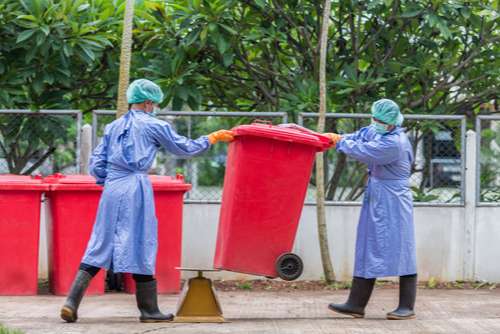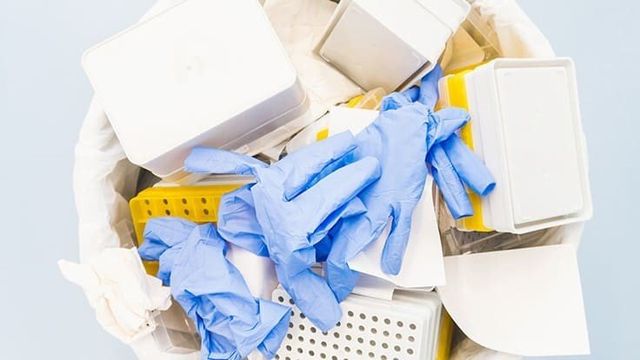Your Relied On Companion: Medical Waste Removal Services Tailored to Your Demands
Your Relied On Companion: Medical Waste Removal Services Tailored to Your Demands
Blog Article
Stay Ahead of Laws: Professional Suggestions on Medical Waste Disposal
In a globe where the health care market is constantly advancing, it is imperative for clinical facilities to remain in advance of policies when it comes to the correct disposal of clinical waste. From understanding the various classifications of clinical waste to carrying out the best collection and partition techniques, this discussion will certainly provide workable suggestions and valuable understandings to help centers remain ahead of laws in the ever-changing landscape of medical waste disposal.
Recognizing Medical Waste Categories
Recognizing medical waste groups is vital for correct disposal and monitoring in health care centers. Medical waste describes any waste produced by medical care activities that might posture a risk to public wellness or the environment. It is vital to categorize medical waste properly to ensure its risk-free handling, transportation, disposal, and therapy.
There are a number of groups of clinical waste that healthcare facilities need to be knowledgeable about. One of the most common classifications consist of transmittable waste, pathological waste, sharps waste, pharmaceutical waste, and chemical waste. Each group has specific guidelines and guidelines for its correct monitoring and disposal.
Pathological waste refers to human cells, body organs, or body components that need special handling and disposal. Pharmaceutical waste comprises expired, extra, or polluted medications that need cautious handling and disposal.
Staying Up-To-Date With Regulatory Changes
Remaining present with regulative modifications is essential for health care facilities to make certain conformity and appropriate administration of medical garbage disposal. medical waste removal. With guidelines regularly developing, it is important for medical care centers to stay updated to prevent penalties, penalties, and prospective harm to the setting and public health and wellness
To stay in advance of regulative changes, health care facilities need to establish a system for monitoring and tracking updates. This can be done by registering for regulative newsletters, going to workshops and meetings, and actively taking part in industry organizations. Additionally, centers should mark a staff participant or team in charge of remaining notified and sharing information to appropriate stakeholders.
Regular communication with governing agencies is additionally important. Health care centers ought to develop relationships with regional, state, and government agencies to ensure they know any modifications in regulations that may influence their waste management methods. This can be done via regular conferences, engagement in public comment periods, and aggressive involvement with regulatory companies.
Furthermore, medical care facilities need to think about partnering with waste monitoring business that specialize in medical garbage disposal (medical waste disposal services with WasteX). These firms are frequently skilled in the most recent regulations and can offer assistance and assistance to make certain compliance
Executing Appropriate Collection and Segregation Techniques
To successfully take care of clinical garbage disposal, medical care centers have to develop correct collection and segregation methods according to governing standards. Applying these methods makes certain the risk-free handling and disposal of possibly hazardous products, shields the setting, and reduces the threat of injuries and infections to health care employees and the general public.
Correct collection and segregation techniques include using designated containers and classifying systems. Medical care centers must give plainly identified containers for different sorts of clinical waste, such as sharps, contagious waste, pharmaceutical waste, and non-hazardous waste. These containers ought to be color-coded and clearly significant to prevent confusion and advertise simple identification.
Additionally, medical care facilities should educate their personnel on the appropriate treatments for accumulating and segregating medical waste. This consists of informing them on the various types of waste, the proper containers to utilize, and the value of following regulations and standards. Regular training sessions and correspondence course need to be carried out to ensure that employee continue to be updated on ideal methods.
Furthermore, medical care facilities must establish a system for routine collection and disposal of clinical waste. This may entail partnering with certified waste monitoring companies that concentrate on medical garbage disposal. These firms will make certain that the collected waste is transferred and thrown away in conformity with regulatory demands.
Picking the Right Disposal Techniques

Incineration is one of the most typical and efficient approaches for disposing of certain types of medical waste, such as pathological waste and sharps. It involves the controlled combustion of waste medical waste disposal services with WasteX at high temperatures, reducing it to ash. Incineration can launch unsafe toxins right into the air and contribute to air pollution.

Various other disposal methods consist of chemical treatment, microwave therapy, and landfilling. Chemical treatment includes using chemicals to neutralize the waste and decontaminate. Microwave treatment makes use of microwave energy to warmth and disinfect the waste. Landfilling entails burying the waste in go now an assigned landfill area (medical waste disposal services with WasteX). However, landfilling must be the last hotel as a result of the potential risk of contamination to soil and groundwater.
Ensuring Compliance Through Documentation and Training
After carefully considering the suitable disposal methods for medical waste, healthcare facilities must ensure conformity with laws and decrease ecological effect by carrying out efficient paperwork and training procedures. This action is critical in keeping a secure and lasting environment for both medical care employees and the basic public.

Training is just as important in making sure conformity with regulations. Healthcare workers that take care of medical waste ought to get proper training on waste partition, handling, and disposal procedures. This training ought to cover subjects such as the appropriate usage of individual safety equipment, identification of different types of waste, and the right disposal approaches for each and every waste category. By providing extensive training, health care facilities can equip their personnel to make educated choices and lessen medical waste disposal services with WasteX the threat of inappropriate garbage disposal.
Final Thought
In final thought, staying ahead of regulations in clinical garbage disposal is vital for health care facilities. medical waste removal service. Understanding the different groups of medical waste, staying upgraded with governing modifications, executing proper collection and partition techniques, choosing the ideal disposal techniques, and guaranteeing compliance via paperwork and training are all important actions. By complying with these guidelines, medical care organizations can effectively take care of and dispose of clinical waste in a liable and safe fashion
From comprehending the various classifications of clinical waste to carrying out the right collection and partition approaches, this conversation will certainly provide workable tips and valuable insights to aid facilities stay in advance of regulations in the ever-changing landscape of medical waste disposal. - medical waste disposal services with WasteX
The most usual groups consist of contagious waste, pathological waste, sharps waste, pharmaceutical waste, and chemical waste. Healthcare centers should give plainly labeled containers for different types of medical waste, such as sharps, infectious waste, pharmaceutical waste, and non-hazardous waste. Medical care centers must develop a detailed system to tape-record and track all elements of medical waste disposal, consisting of types of waste created, quantities, and disposal techniques utilized. Healthcare employees that take care of clinical waste must receive ideal training on waste segregation, managing, and disposal procedures.
Report this page